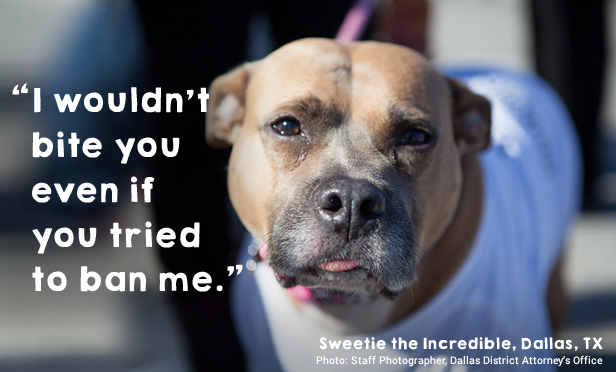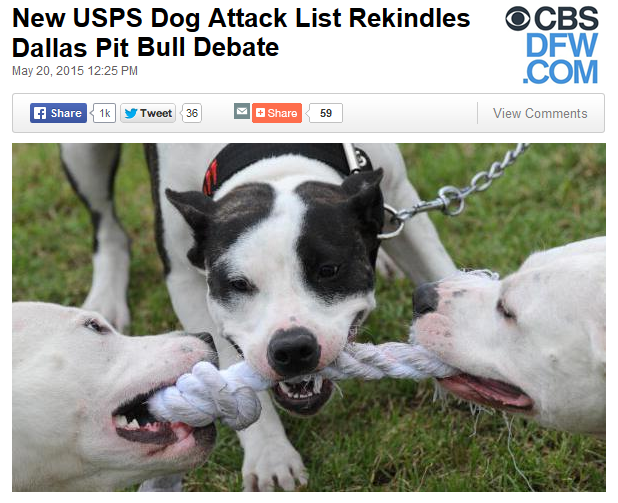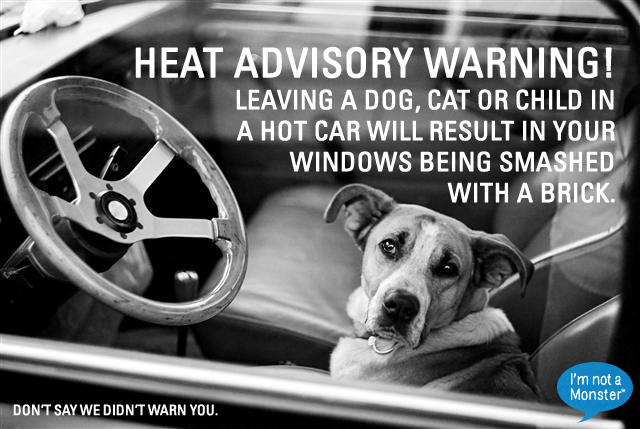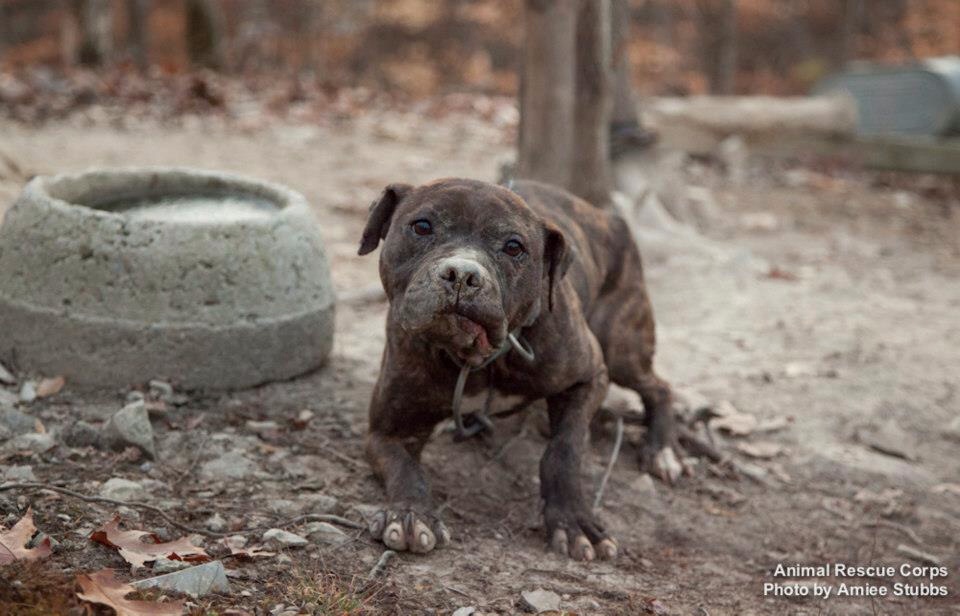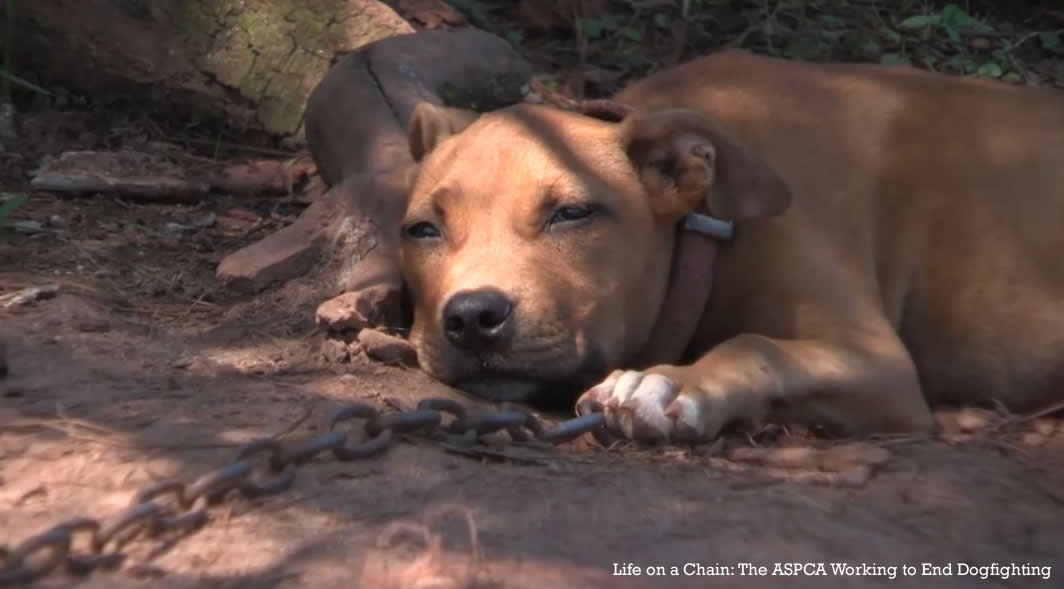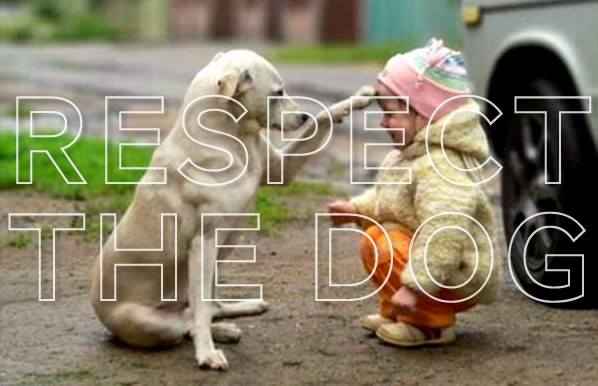
As part of National Dog Bite Prevention week, here are some facts, tools & resources that can help prevent dog bites and improve our community by educating people about responsible dog ownership.
We’ve come across many videos showing alarming interaction between kids & dogs. Clueless parents in the background videotaping and laughing at the seemingly harmless interactions. When dogs are showing teeth and nipping at your kid, it’s NOT funny nor cute nor harmless. And as guardians of the breeds most sensationalized by the media in regards to dog bites, please pay heed.
____________________________________________________________________
There are 70 million nice dogs, but ANY DOG CAN BITE. Information and education are the best solutions for this public health crisis.
“Even the cuddliest, fuzziest,sweetest pup can bite if provoked. Most people are bitten by their own dog or one they know. Some owners actually promote aggression in their dogs or allow aggression to go unchecked. Although media reports and rumors often give the impression that certain breeds of dog are more likely to bite, there is little scientific evidence to support those claims,” American Veterinary Medical Association (AVMA) added.
Dog Bite Facts
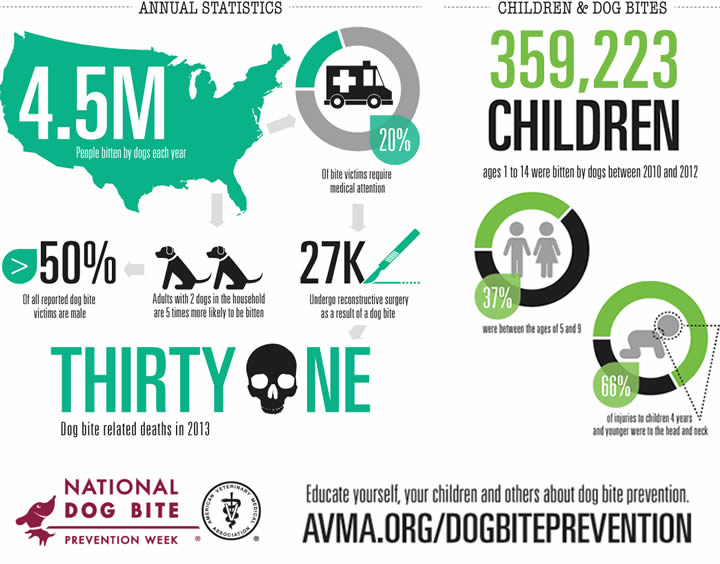
Partial infographic. Get the full AVMA’s Dog Bites by the Numbers Infographic
- Each year, more than 4.5 million people in the U.S. are bitten by dogs
- Almost 1 in 5 people bitten by dogs require medical attention
- Every year, more than 800,000 Americans receive medical attention for dog bites; at least half of them are children
- Children are, by far, the most common victims of dog bites and are far more likely to be severely injured
- Most dog bites affecting young children occur during everyday activities and while interacting with familiar dogs
- Senior citizens are the second most common dog bite victims
Why Do Dogs Bite?
There are several possible reasons why a dog may bite a child (or anyone):
- The dog is protecting a possession, food or water dish or puppies
- The dog is protecting a resting place
- The dog is protecting its owner or the owner’s property
- The child has done something to provoke or frighten the dog (e.g., hugging the dog, moving into the dog’s space, leaning or stepping over the dog, trying to take something from the dog)
- The dog is old and grumpy and having a bad day and has no patience for the actions of a child
- The dog is injured or sick
- The child has hurt or startled it by stepping on it, poking it or pulling its fur, tail or ears
- The dog has not learned bite inhibition and bites hard by accident when the child offers food or a toy to the dog
- The child and dog are engaging in rough play and the dog gets overly excited
- The dog views the child as a prey item because the child is running and/or screaming near the dog or riding a bicycle or otherwise moving past the dog
- The dog is of a herding breed and nips while trying to “herd” the children
In addition, a recent study (by Tufts University, et al) examining the circumstances surrounding 256 dog bite-related fatalities (DBRFs) in the United States found 7 major co-occurring factors:
- Absence of an able bodied person to intervene (occurred in 87.1% of cases)
- Incidental or no relationship between victim and dog (85.2%)
- Owner failure to neuter dogs (84.4%)
- Compromised ability of victims to interact appropriately with dogs (victims were either <5 years old or had a limited physical or mental capacity) (77.4%)
- Dogs kept isolated from regular positive human interactions vs family dogs (76.2%)
- Owner’s prior mismanagement of dogs (37.5%)
- Owner’s history of abuse or neglect of dogs (21.1%)
Four or more of these factors co-occurred in 80.5% of deaths. The study concluded that most DBRFs were characterized by coincident, preventable factors, and breed was not one of these (20 breeds, including 2 known mixes, were identified).* This study supports multifactorial approaches for dog bite prevention, not single-factor solutions such as breed specific legislation. Key takeaway: all of the co-occurring factors are human-controlled.
Fortunately, there are steps we can take to address and avoid dog bites, from properly training and socializing your pets, learning to read your dog’s body language and recognizing the triggers to educating your children (and adults) on how – or if – they should approach a dog and to safely interact with the dog.
Do Dogs Bite “Out of the Blue”?
No, dogs do not bite “out of the blue.” There are always warning signs before a bite occurs, but these can be very subtle and may be missed by many people. A dog may appear to tolerate being repeatedly mauled by a child and one day bites, surprising everyone. Sometimes the warning have gone on for months or even years before the dog finally loses its tolerance and bites.
Read this great article by Madeline Gabriel that explains that dogs do not bite “out of the blue”.
People who own good dogs sometimes are lulled into a sense of safety and lax because “good dogs don’t bite children…or do they?” Often times, once you determine that you have a “Good Dog” you tend to leave it at that and just go about your life with dog and baby. What we forget to consider is that just like us, dogs have good days and bad days. On any given day, at any given time, your dog is somewhere along that continuum. Have you ever had one of those days? You know…bad day at work, skipped lunch, lots of traffic, big headache? You come home and even something minor goes wrong and isn’t it possible that you may “snap” at someone you love?
It’s the same with dogs. Even over the course of a single day, your dog may go from feeling relaxed and easy-going to tense and cranky — just like you. Living with babies and small children can make for a grueling day. That 4:30-6:30 time that used to be known as Happy Hour? It’s often the LEAST happy time with tired parents, babies crying, kids squabbling and a parent trying to make dinner. Everyone is a bit on edge and that includes the family dog.
The trick to preventing bites is to really look at your dog. What does he or she look like when relaxed and happy? What changes when your dog is getting a little worried or overwhelmed? Where is your dog right now on that body language continuum? Take mental snapshots throughout the day and place your dog along that line. Learn the body language changes that signal moves in one direction or another. (See Look, Ma! My Body Is Talking to You!)
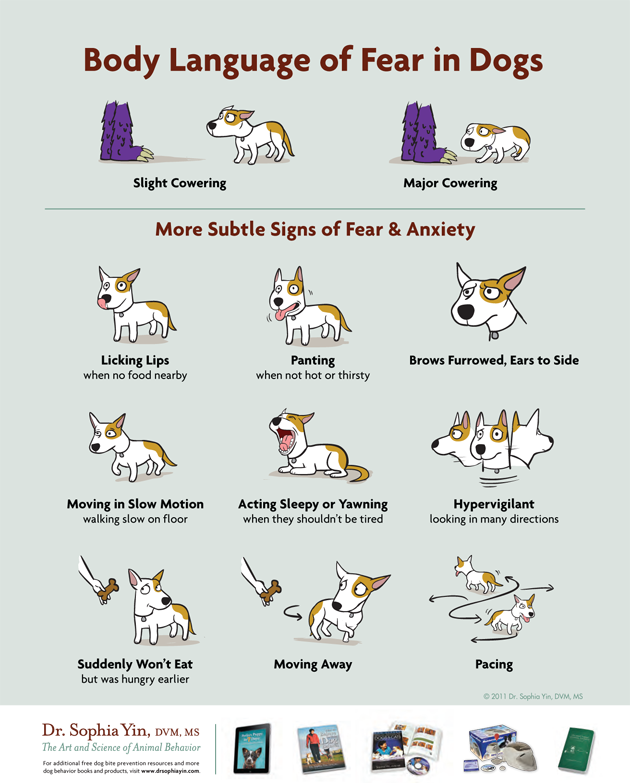
Learn the difference in expressions of dogs that are happy and dogs that want to be left alone:
Stress to children that they should only pet happy dogs. You may think that your dog loves to have the children climbing all over him and hugging him, but if you see any of these signs, then you are being warned that a bite could occur if the dog feels he has no other way of defending himself. Do your dog and your child a favor and intervene if you notice any of these signs.
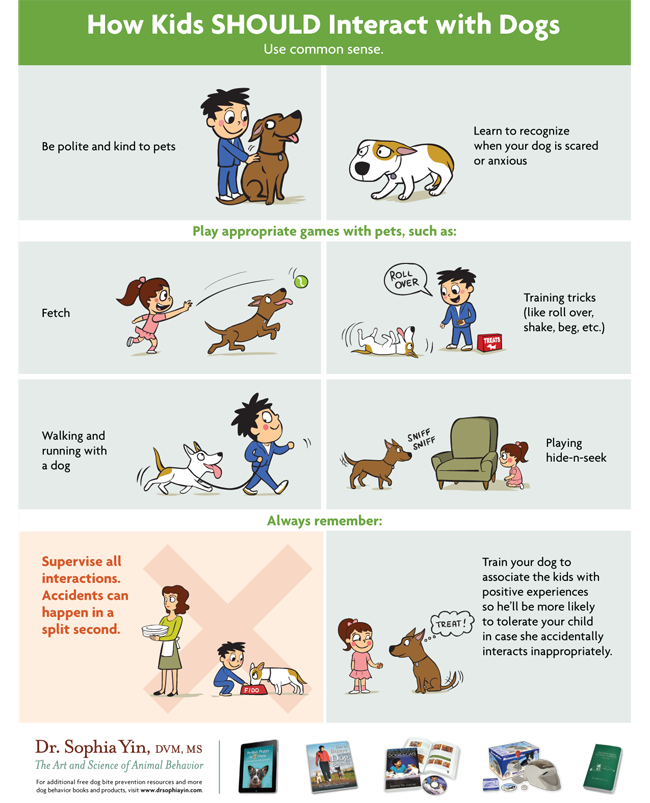
Signs that you should take very seriously that indicate that the dog is saying “I have been very patient with this child, but I am nearing the end of my patience”, include:
- The dog gets up and moves away from the child
- The dog turns his head away from the child
- The dog looks at you with a pleading expression
- You can see the “whites” of the dogs eyes, in a half moon shape
- The dog yawns while the child approaches or is interacting with him
- The dog licks his chops while the child approaches or is interacting with him
- The dog suddenly starts scratching, biting or licking himself
- The dog does a big “wet dog shake” after the child stops touching him
From For the Love of a Dog, by Patricia McConnell, PhD:
“I don’t know how many times broken-hearted clients have told me that Barney had been doing so well; he’d handled the noise and chaos of the family picnic all day long, but just when everyone was about to leave, he fell apart and snapped, or nipped, or bit…If people could just see the signs of exhaustion or worry on their dogs’ faces, there’d be a lot fewer bites in the world, a lot fewer tears, and a lot more dogs living to old age.”
Avoid Trigger Stacking
Again: dogs don’t bite “out of blue.” Sometimes nice dogs have just been subjected to one too many stressors and the result is a bite. Read this article by Casey Lomonaco that gives an example of how this stress load can accumulate and how a dog bite is like a games of Tetris:
“Bites are usually caused by an accumulation of stressors. Each time a dog is exposed to a stressor, stress hormones are dumped into the brain. These stress hormones are like the puzzle pieces in Tetris. They build up over time. You have to actively reduce the stress (like a Tetris player clearing lines) through management, desensitization, counter conditioning, and general stress reduction techniques. If you are not taking steps to reduce the stress, it begins to accumulate. The dumping of stress hormones into the brain leaves the dog increasingly sensitized to stressors, which replicates the puzzle pieces dropping faster and faster until you eventually reach the threshold. Soon, the dog bites. The game is over.”
Stressors vary in individual dogs. One dog may be stressed by loud noises, nail trimming, men with beards, foul weather and a bad diet. Another dog may not seemingly respond to these factors but is sensitive to visits to the vet’s office, small children, cats, people that smell like beer, dogs walking past the fenced in yard, and people approaching or entering the home. Every dog has stressors (commonly called “triggers”) and a big part of effective behavioral modification strategies is identifying these as accurately and thoroughly as possible, which allows behavior consultants and handlers to focus their efforts most efficiently. Stressors, like Tetris pieces, accumulate over time.
When the dog encounters one of his triggers, he might display low levels of stress such as sniffing the ground or a tongue flick or he may show aggression such as a freeze or a growl. When multiple stressors happen at the same time or very close together, they will have a cumulative effect on the dog’s bite threshold. This is called trigger stacking and it explains why a dog who has never bitten in the past bites, because he was pushed over his bite threshold.
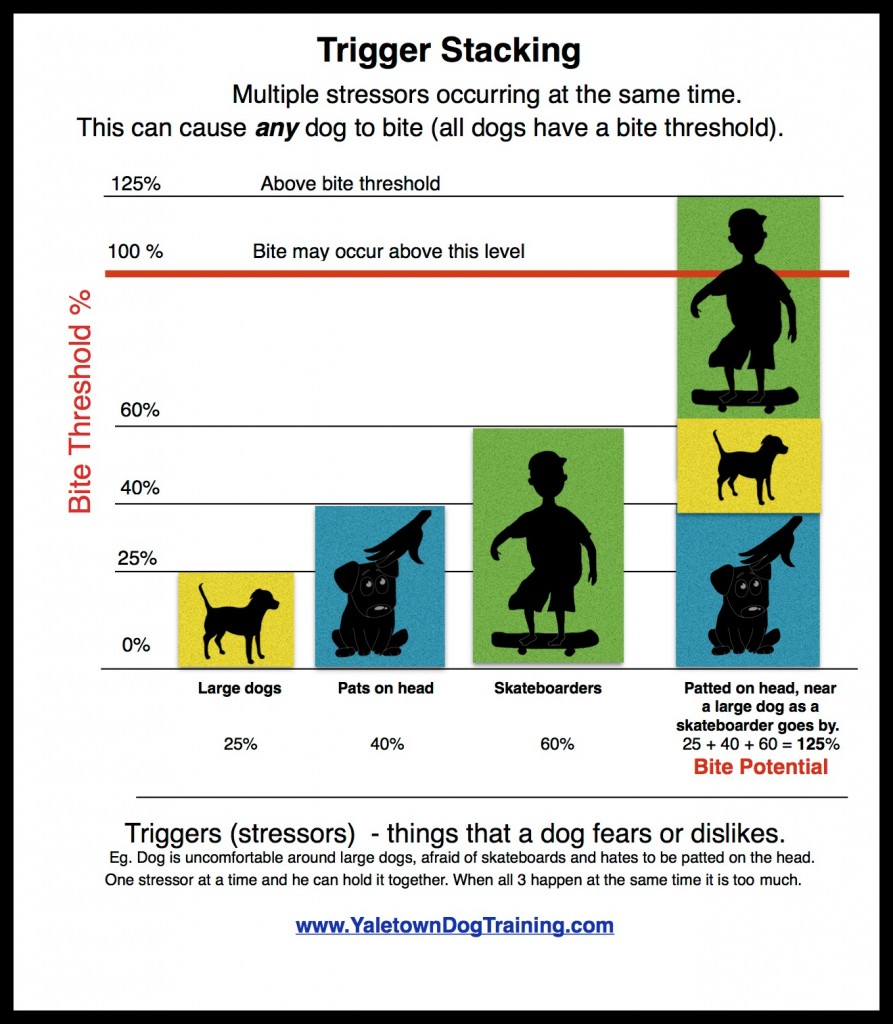
Supervise, Supervise, Supervise
Never leave a child unattended with your pets. You want to be PROACTIVE and ACTIVE. Even if you are familiar with dog body language and communication, and know what to look for that indicates stress or conflict, always be proactive and active. And remember, dogs do NOT bite out of the blue.
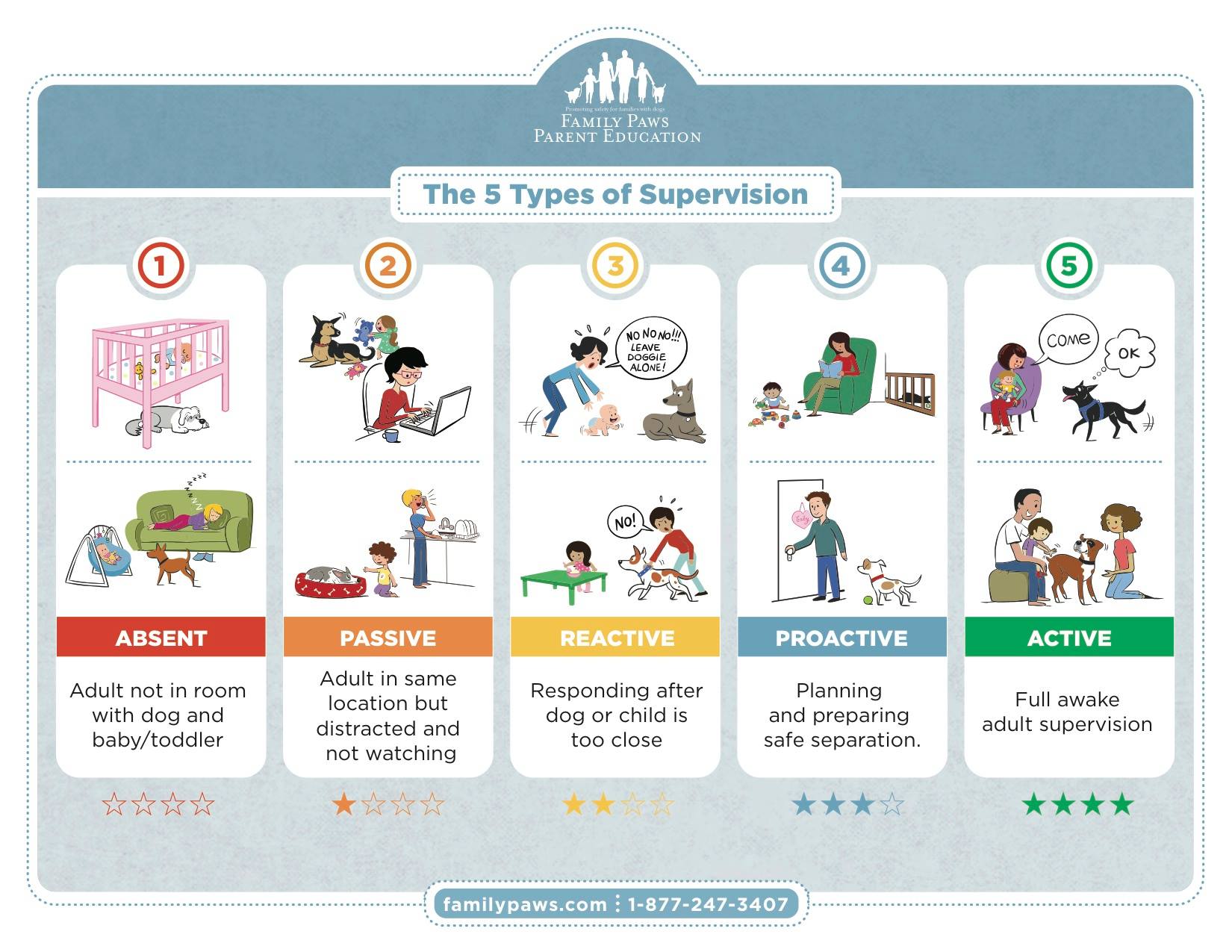
“Supervision is not well understood,” said Dr. Ilana Reisner, a board-certified veterinary behaviorist and consultant on dog bite safety who recently presented tips for parents during a National Press Club event hosted by State Farm and the United States Postal Service. “Dog owners in general are lacking knowledge about what kinds of things dogs and children do that can be a risk. For example, they might go out of the room and prepare lunch while the child is alone with the dog maybe 10-20 feet away, and that’s not active supervision. If that’s one message we can get across I think it would prevent a lot of bites.”
Breed bias can also play a factor in dog bites to children. While breed bias often reflects unfounded fears toward breeds that may be a danger to our kids, it can also work the other way, when dogs considered to be “safe” are allowed to interact unsupervised with children.
“Just because you happen to have a dog that’s considered to be a great family pet doesn’t mean that it would be safe for a toddler to crawl up to that dog and give him a hug when he’s sleeping,” Dr. Reisner said.
Of course, proper interaction applies to adults as well. Check out this illustration by Doggie Drawings on how NOT to greet a dog.
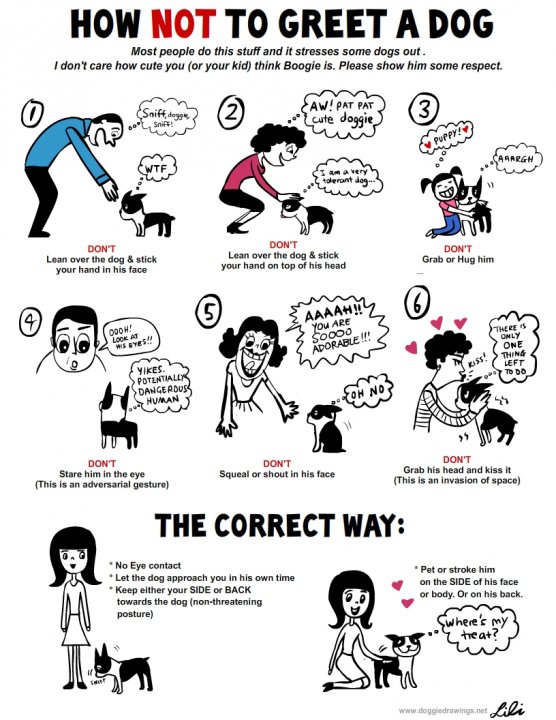
And ALWAYS ask the person handling the dog if it’s OK to greet it before you walk up to it. Not every dog is OK with strangers coming up to them and that’s OK.
So, please remember:
- Prevention is the way to go
- Dogs don’t bite “out of the blue”: Learn to read a dog’s body language and teach children to only pet happy dogs
- Supervise: Never leave a child unattended with your pets, ever!
- Breed does not matter: Any dog can bite, regardless of breed. Just because a dog is a pug or a poodle doesn’t mean it won’t bite if pushed too far
- Know the triggers: Know your dog’s triggers and do your best to avoid putting him into those situations that just might push him too far. And watch out for overload of triggers. Set your dog up for success and avoid accumulation of stressors by taking your dog out of the situation
- Respect the dog: Every dog has the right to say no. If your dog is saying “no,” you have to respect that. And teach your kids to respect that
At every moment of the day, your dog is giving you a status update. Understanding what a dog’s behavior is telling us and how our behavior may be interpreted by a dog is essential to reducing dog bites. Know when they look stressed, and be ready to remove them for the situation when necessary. You just need to look and your dog will tell you.
Because at the end, it’s the kid AND the dog that pay the price. All because of the clueless and careless parents.
Always remember to be your dog’s advocate. Let’s make your family and community safer through education and responsible pet ownership.
____________________________________________________________________
Resources:
AVMA’s Dog Bite Prevention
AVMA’s Dog Bites by the Numbers Infographic
Doggone Safe
Dog Bite Prevention brochure (PDF)
How Not to Greet A Dog poster
How Kids and Pets Should Not Interact poster (PDF)
How Kids and Pets Should Interact poster (PDF)
Teach Kids to Be a Tree
Co-occurrence of Potentially Preventable Factors in 256 Dog Bite-related Fatalities in the United States (2000-2009)
p.s. Responsible dog ownership and public education must be a primary focus of any dog bite prevention policy. Read why BSL is an ineffective response.
*For 401 dogs described in various media accounts, reported breed differed for 124 (30.9%); for 346 dogs with both media and animal control breed reports, breed differed for 139 (40.2%). Valid breed determination was possible for only 45 (17.6%) DBRFs; 20 breeds, including 2 known mixes, were identified. The study was conducted by Cummings School of Veterinary Medicine at Tufts University; Sue Binder Consulting Inc, National Canine Research Council & Center for Shelter Dogs at the Animal Rescue League of Boston. Published in Journal of the American Veterinary Medical Association on December 15, 2013.
Sources: American Veterinary Medical Association (AVMA), Doggone Safe, Dr. Sophia Yin,For the Love of a Dog, Dogster, Yaletown Dog Training, Journal of the American Veterinary Medical Association
____________________________________________________________________
